Related Research Articles

Emergency medical services (EMS), also known as ambulance services or paramedic services, are emergency services that provide urgent pre-hospital treatment and stabilisation for serious illness and injuries and transport to definitive care. They may also be known as a first aid squad, FAST squad, emergency squad, ambulance squad, ambulance corps, life squad or by other initialisms such as EMAS or EMARS.

An emergency medical technician (EMT), also known as an ambulance technician, is a health professional that provides emergency medical services. EMTs are most commonly found working in ambulances.
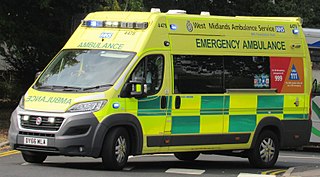
An ambulance is a medically equipped vehicle which transports patients to treatment facilities, such as hospitals. Typically, out-of-hospital medical care is provided to the patient during the transport.
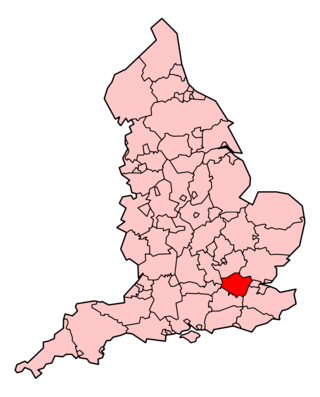
The London Ambulance Service NHS Trust (LAS) is an NHS trust responsible for operating ambulances and answering and responding to urgent and emergency medical situations within the London region of England. The service responds to 999 phone calls across the region, and 111 phone calls from certain parts, providing triage and advice to enable an appropriate level of response.

A nontransporting EMS vehicle, also known as a fly-car, response vehicle, quick response service (QRS) vehicle, or fast response vehicle, is a vehicle that responds to and provides emergency medical services (EMS) without the ability to transport patients. For patients whose condition requires transport, an ambulance is necessary. In some cases they may fulfill other duties when not participating in EMS operations, such as policing or fire suppression.

NSW Ambulance, previously the Ambulance Service of NSW, is an agency of NSW Health and the statutory provider of pre-hospital emergency care and ambulance services in the state of New South Wales, Australia.

The Northern Ireland Ambulance Service is an ambulance service that serves the whole of Northern Ireland, approximately 1.9 million people. As with other ambulance services in the United Kingdom, it does not charge its patients directly for its services, but instead receives funding through general taxation. It responds to medical emergencies in Northern Ireland with the 300-plus ambulance vehicles at its disposal. Its fleet includes mini-buses, ambulance officers' cars, support vehicles, RRVs and accident and emergency ambulances.
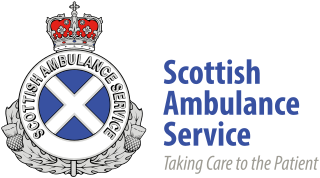
The Scottish Ambulance Service is part of NHS Scotland, which serves all of Scotland's population. The Scottish Ambulance Service is governed by a special health board and is funded directly by the Health and Social Care Directorates of the Scottish Government.

The Welsh Ambulance Services NHS Trust is the national ambulance service for Wales. It was established on 1 April 1998 and as of December 2018 has 3,400 staff providing ambulance and related services to the 3 million residents of Wales.
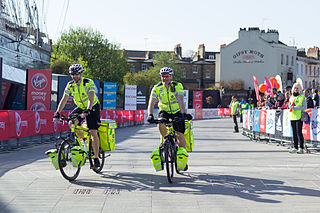
St John Ambulance is a volunteer-led, charitable non-governmental organisation dedicated to the teaching and practice of first aid and the support of the national emergency response system in England. Along with St John Ambulance Cymru, St John Ambulance Northern Ireland, and St John Scotland, it is one of four United Kingdom affiliates of the international St John Ambulance movement.

The East of England Ambulance Service NHS Trust (EEAST) is an NHS trust responsible for providing National Health Service (NHS) ambulance services in the counties of Bedfordshire, Cambridgeshire, Essex, Hertfordshire, Norfolk and Suffolk, in the East of England region. These consist of approximately 6.2 million people across an area of 7,500 square miles (19,000 km2).

The West Midlands Ambulance Service University NHS Foundation Trust (WMAS) is responsible for providing NHS ambulance services within the West Midlands region of England. It is one of ten ambulance trusts providing England with emergency medical services, and is part of the National Health Service.

Louisville Metro Emergency Medical Services is the primary provider of pre-hospital life support and emergency care within Louisville-Jefferson County, Kentucky. LMEMS is a governmental department that averages 90,000 calls for service, both emergency and non-emergency, each year.

Jefferson County Emergency Medical Services was the primary advanced life support provider for Jefferson County, Kentucky outside the limits of the City of Louisville. The merger of Jefferson County Government with the City of Louisville brought about the combining of JCEMS with the EMS bureau of the Louisville Division of Fire to form Louisville Metro EMS in early 2005. Therefore, as a separate and distinct entity, it no longer exists.
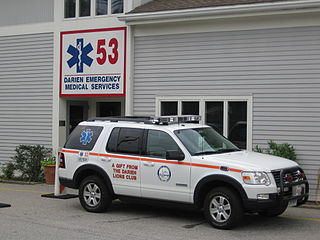
In the United States, emergency medical services (EMS) provide out-of-hospital acute medical care and/or transport to definitive care for those in need. They are regulated at the most basic level by the National Highway Traffic Safety Administration, which sets the minimum standards that all states' EMS providers must meet, and regulated more strictly by individual state governments, which often require higher standards from the services they oversee.
An emergency care assistant (ECA) is a type of NHS ambulance service worker in the United Kingdom, often used to support paramedics in responding to emergency calls.
The National Ambulance Service is the statutory public ambulance service in Ireland. The service is operated by the National Hospitals Office of the Health Service Executive, the Irish national healthcare authority.

New Orleans Emergency Medical Services is the primary provider of advanced life support emergency medical services to the city of New Orleans, Louisiana, United States. Unlike most other emergency medical services in the United States, New Orleans EMS operates as a third service and is not part of the New Orleans Fire Department; rather, New Orleans EMS is operated by the New Orleans Health Department and the New Orleans Office of Homeland Security and Emergency Preparedness.
The New York City Fire Department Bureau of Emergency Medical Services is a division of the New York City Fire Department (FDNY) in charge of emergency medical services for New York City. It was established on March 17, 1996, following the merger of the FDNY and New York City Health and Hospitals Corporation's emergency medical services division. FDNY EMS provides coverage of all five boroughs of New York City with ambulances and a variety of specialized response vehicles.

The Ambulance Service Long Service and Good Conduct Medal is a long service medal of the United Kingdom established in 1995. The medal is awarded to recognise long service by all clinical grades of the ambulance services who serve on emergency duty.
References
- ↑ "New ambulance service to 'measure seriousness' of 999 calls". BBC. 13 October 2022. Retrieved 17 November 2022.
- ↑ "Ambulance response programme introduced in Jersey". Jersey Evening Post. 13 October 2022. Retrieved 17 November 2022.
- ↑ "Ambulance Service launches volunteer responders scheme". Jersey Evening Post. 7 July 2022. Retrieved 17 November 2022.
- ↑ "Independent review into Jersey emergency services reveals lack of staff and inadequate funding". ITV. 3 November 2022. Retrieved 17 November 2022.
- ↑ "Paramedics |". www.hcpc-uk.org. Retrieved 2023-03-12.
- 1 2 Jersey Ambulance: Part 3 | ITV News , retrieved 2023-02-19
- 1 2 "Jersey flat explosion: Woman, 73, becomes 10th person confirmed dead". Sky News. Retrieved 2023-02-19.
- 1 2 Jersey, States of. "Government of Jersey". gov.je. Retrieved 2023-02-19.